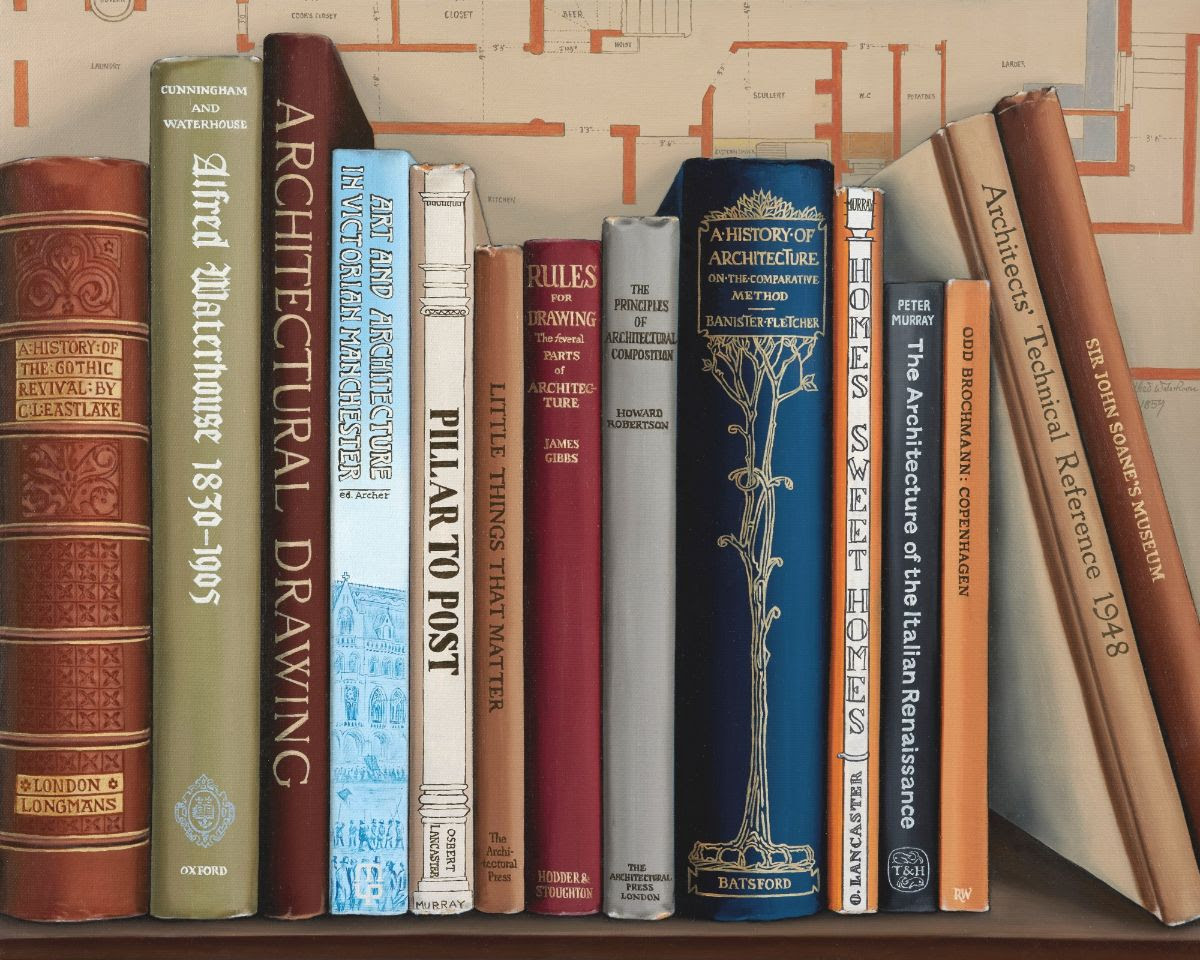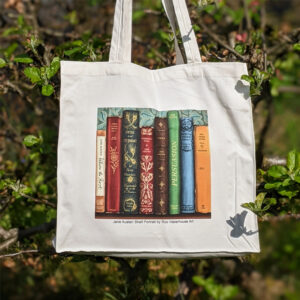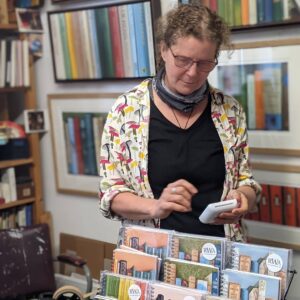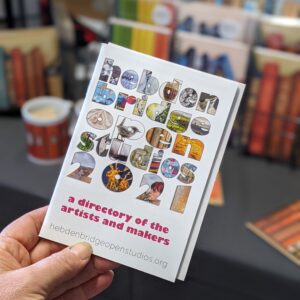|
||||||||||||||||||||||||
|
Paperback painter
by Simon Warner July 6th 2022
A British artist’s love of literature extends the shelf life of Beat book titles as she turns covers into originals
IN A LITERARY universe not so far away, Allen Ginsberg rubs shoulders with Bob Dylan, Tom Waits nestles up to Jack Kerouac and Neal Cassady and Jerry Garcia remain forever fellow travellers in the realm of New Journalism. Such cultural cross-fertilisation, through the medium of books, is given fresh life in the latest depiction on canvas by the UK painter Roo Waterhouse.
The North of England-based artist has taken a fistful of Beat classics – alongside a number of titles frequently linked to that scene – to present her very own shelfie: immaculately wrought re-creations of a collection of book spines captured in oil, her favourite material of choice.
Waterhouse has pursued what she has christened her ‘Shelf Portraits’ for some time – the latest Beat Generation snapshot, entitled Beatitude, is merely the latest in a series that runs to dozens of subjects. Some are random and eclectic rows of books; others are carefully themed with science-fiction, Jane Austen and Penguin Crime among the chosen topics.
Pictured above: Beatitude by Roo Waterhouse, 2022, oil on canvas, 30x40cm, £1,400*
Her approach to making art, which draws on a number of key painterly and graphic skills, brings to mind an intriguing creative movement, a significant reaction to the prevailing abstraction, that flowered in the latter decades of the last century.
Between the Pop postures of Rosenquist, Rauschenberg and Lichtenstein and the conceptual constructions of Hirst, Emin and Creed, modern art experienced the emergence of a style dubbed hyperrealism, sometimes referred to as superrealism, in which painters rendered portraits of the real world so unerringly accurate they moved beyond the mere photographic to another visual level.
American figures like Richard Estes, Duane Hanson, Chuck Close and Carol Feuerman were among those hailed creatives who produced two and three-dimensional work which captured another level of near-perfect reality in their paintings and sculptures.
Now Waterhouse has brought that precise eye for detail to the books she illustrates with such painstaking skill. Not only are the distinctive typography and unique pantones re-born – look at the lettering and dazzlingly memorable turquoise in that famed Tom Wolfe edition, for example – but the creases and cracks, the rubbings and wear, present on every well-thumbed softback are lovingly restored in these eye-catching updated versions.
INTERVIEW with Roo Waterhouse (pictured above; Credit: Lucy Cartwright, 2022)
Where did you train/study? I have studied Art Foundation at Chelsea School of Art; Typographic Design at the London College of Printing and taken a Visual Art Degree at Leeds Met University.
Where are you originally from? Are you based in West Yorkshire now? I’m originally from London, but came up to West Yorkshire for a weekend 30 years ago and have been happily settled in Hebden Bridge ever since!
How long have you been painting ‘Shelf Portraits’? I have been developing my ‘Shelf Portrait’ oil paintings over the last 12 years.
What gave you the idea/inspiration? I was a keen reader as a child, and grew up in a house full of treasured books. My artwork has always been themed around how the possessions we choose to keep around us can hold on to parts of our story, giving us a sense of place, a sense of our history. Books play an especially important role, our bookshelves becoming a reflection of our lives. In my work I aim to give reverence to their significance. Back around 2010 an author friend asked me to paint her books alongside her husband’s books for a commission, and the ‘Shelf Portrait’ theme has snowballed from there onwards….
How long does a ‘Shelf Portrait’ take? What are the challenges? I tend to work on a few ‘Shelf Portrait’ paintings at once, over a period of several months, as each one involves a layering up of the oil paint, with each layer needing to dry before the next is applied (so timing and deadlines are often the biggest challenge!). The final layers are the typography and fine details – my favourite bits! There is not much I enjoy more than spending hours hand-rendering lettering.
How do you select your subject material? I tend to be inspired by the shelves of second-hand bookshops, or those of people’s houses I visit – I’m always on the lookout for an inspiring shelf!
Why did you go for a Beat-themed example? The Beat painting was inspired by the Kerouac collection at the house of a bespoke ‘Shelf Portrait’ client.
You have made very interesting selections in relation to the Beat theme: what made you include, for example, a fairly esoteric example like Robert Bly?! I’m not an expert on Beat myself, so I did some research to try and get the balance of books right, not too light, but not too specialist – I hope it worked! I included Tom Robbins, Tom Wolfe and Ken Kesey as they are authors who I have enjoyed myself.
Do you have input as to the material you paint? Do you take specialist advice? For paintings destined for galleries and art fairs I choose my own themes, often inspired by shelves I come across, or by comments from viewers at exhibitions, book festivals and open studios events. I often get in touch with any enthusiasts I know in the field for their opinion on important books to include, and for reference images of the spines if I can’t get hold of them myself.
You say that many of your ‘Shelf Portraits’ are eclectic and random. Which themed examples have you done so far? Many themes, including: Birds; Brontes; Science Fiction; Austen; Dickens; Penguin Classics; Ladybird Books; cook books; Penguin Crime; Gardening; Childhood Favourites; Anne Lister; Scotland; Architecture; Insects…the list goes on!!
Are you a fan of literature yourself? What are your favourite books? Who are your favourite writers? My love of reading increases the longer I paint books! I am drawn to contemporary fiction about ordinary people living their extra-ordinary lives. I’m currently reading Elif Shafak’s The Island of Missing Trees, which is certainly my favourite book this year. I am also increasingly interested in observational nature writing, my current favourite being Kathleen Jamie.
What interest has the project attracted so far? Interest has been fabulous with regular sales at London art fairs and through galleries.
Have people requested commissions? Around half the ‘Shelf Portraits’ I paint are bespoke commissions, where clients choose their most treasured books to be painted together. A good number of these are for book collectors, unsurprisingly!! I enjoy bespoke paintings the most as I love to build a connection with the subject through discussing with the clients which books they have chosen and why.
Visit: www.roowaterhouse.art
*Key to book titles: William Burroughs, Naked Lunch; Allen Ginsberg, Howl and Other Poems; Neal Cassady, The First Third; Carolyn Cassady, Off the Road; Diane di Prima, Revolutionary Letters; Jack Kerouac, On the Road; Bob. Dylan, Tarantula; Beatitude Anthology; Hunter S. Thompson, Fear and Loathing in Las Vegas; Lawrence Ferlinghetti, A Coney Island of the Mind; Robert Bly, The Teeth-Mother Naked at Last; Ken Kesey, One Flew Over the Cuckoo’s Nest; Seymour Krim, The Beats; R. A. Norton, Through Beatnik Eyeballs; Barney Hoskyns, Low Side of the Road; Tom Robbins, Even Cowgirls Get the Blues
Link to Rock and the Beat Generation
Where hip writers meet hot rockers











































